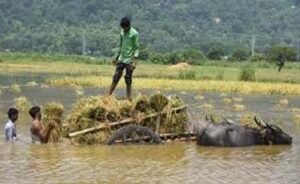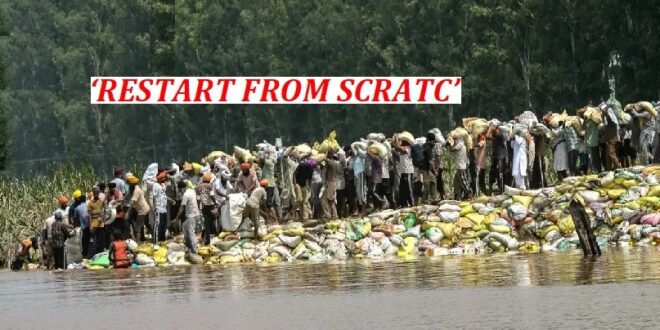24-09-2025
Bureau Report + Agencies
NEW DELHI: After taking multiple economic hits in his household, Gurvinder Singh, a 47-year-old farmer in Gurdaspur, in India’s Punjab state, took a million-rupee loan ($11,000) from a private lender to marry off his eldest daughter. He saved a portion of that and used it to sow 3 acres (1.2 hectares) of paddy.
 He placed his bet on the high-yielding pearl variety of aromatic Basmati rice. A good sale would have given him an earning of nearly 1 million rupees per acre ($11,400 per 0.4 hectares) but now, Singh’s pearl paddy grains lie submerged in floodwater, buried under layers of soil and sediment.
He placed his bet on the high-yielding pearl variety of aromatic Basmati rice. A good sale would have given him an earning of nearly 1 million rupees per acre ($11,400 per 0.4 hectares) but now, Singh’s pearl paddy grains lie submerged in floodwater, buried under layers of soil and sediment.
“I cannot afford this shocking flood at this time in my life. We are ruined,” Singh told media “This year’s harvest was supposed to cover our debts but this field is a lake now, and I don’t know how I will start again.”
Singh also had to temporarily leave his home, along with his wife and two children, after the devastating floods hit their village earlier this month. “What will I go back to?” he wondered.
Northern Indian states have been reeling under the impact of heavy monsoon rains, flash floods and swelling rivers that have submerged entire villages and thousands of hectares of farmland.
In Punjab, where more than 35 percent of the population relies on agriculture, the situation is particularly grim. Here, farmers are facing the worst floods in the last four decades, with large tracts of paddy fields inundated just weeks before harvest. The state cultivates rice in nearly two-thirds of its total geographical area.
Gurdaspur, where Singh lives with his family, has been among the worst flood-hit districts in a region that borders three overflowing rivers, Ravi, Beas, and Sutlej following heavy rainfall in Indian-administered Jammu and Kashmir and Himachal Pradesh state.
At least 51 people have died due to floods in Punjab, and 400,000 more people have been displaced. Singh’s field of paddy contributes to India’s $6bn worth of Basmati exports. Punjab alone accounts for 40 percent of the total production. Across the border, Pakistan’s Punjab province, also submerged in floods, accounts for 90 percent of the country’s Basmati output, generating nearly $900m.
 Initial official estimates put the complete loss of crops in more than 450,000 acres (182,100 hectares) almost the area of Mauritius of farmland in India’s Punjab. Independent agricultural economists told media that the final impact of floods could be five times higher than the official estimate.
Initial official estimates put the complete loss of crops in more than 450,000 acres (182,100 hectares) almost the area of Mauritius of farmland in India’s Punjab. Independent agricultural economists told media that the final impact of floods could be five times higher than the official estimate.
“The crop is completely spoiled, their machinery is submerged, and the farmers’ houses have washed away,” said Lakhwinder Singh, director of the Patiala-based Punjabi University’s Centre for Development Economics and Innovations Studies.
“Punjab’s farmers have to restart from scratch. They would require a lot of support and investment from the government,” Singh told media.
So far, the Punjab government, governed by the Aam Aadmi Party (AAP), which is nationally in opposition to Prime Minister Narendra Modi’s Bharatiya Janata Party has announced a 20,000 Indian rupees ($230) allowance for farmers who lost their crops to flood but that may be too little to deal with the monumental challenges that lie ahead for farmers, said Singh.
Nearly 6 percent of that basmati rice is shipped to the United States, which has slapped a 50 percent tariff on New Delhi. India has traditionally been protectionist towards its agricultural sector, which employs half of India’s population (the world’s largest), a sticking point in trade negotiations with the administration of US President Donald Trump.
 Pressmediaofindia
Pressmediaofindia




